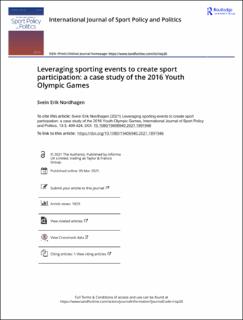Leveraging sporting events to create sport participation: a case study of the 2016 Youth Olympic Games
Peer reviewed, Journal article
Published version
Permanent lenke
https://hdl.handle.net/11250/3025054Utgivelsesdato
2021-03-05Metadata
Vis full innførselSamlinger
Originalversjon
International Journal of Sport Policy and Politics. 2021, 13 (3), 409-424. 10.1080/19406940.2021.1891946Sammendrag
The leverage perspective takes a prospective approach to legacy and focuses on how different organisations use an event as a catalyst to implement their own organisational goals. This paper examines how the second winter Youth Olympic Games (YOG) in Lillehammer in 2016 were leveraged to increase participation in organised and non-organised sport among regional youth. The analytical framework is based on available sport participation leverage literature. This is a case study using interviews with representatives from involved organisations, archival materials and observations as its main sources. The findings show that event organisations, sport organisations and non-sport organisations formed alliances to leverage the 2016 YOG for sport participation with intervention programmes and new infrastructure as the two main strategies. The sport participation legacy outcomes of the 2016 YOG were constrained by a lack of long-term strategies and limited resources made available after the Games. To maximise the sport participation goals, strong alliances and long-term commitments need to be formed among local and regional organisations.

